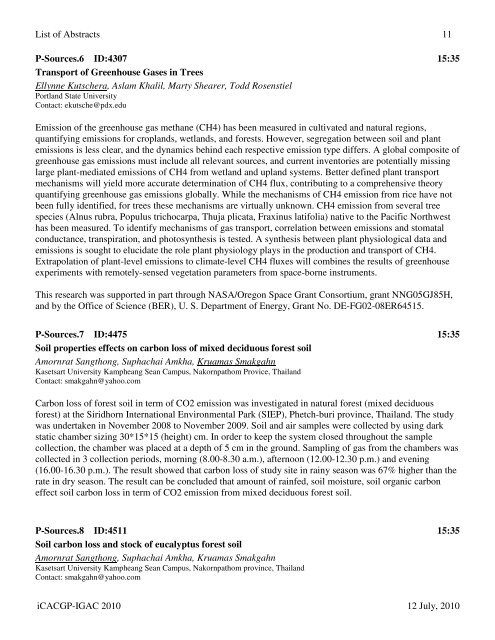Download Abstracts Here - IGAC Project
Download Abstracts Here - IGAC Project
Download Abstracts Here - IGAC Project
You also want an ePaper? Increase the reach of your titles
YUMPU automatically turns print PDFs into web optimized ePapers that Google loves.
List of <strong>Abstracts</strong> 11P-Sources.6 ID:4307 15:35Transport of Greenhouse Gases in TreesEllynne Kutschera, Aslam Khalil, Marty Shearer, Todd RosenstielPortland State UniversityContact: ekutsche@pdx.eduEmission of the greenhouse gas methane (CH4) has been measured in cultivated and natural regions,quantifying emissions for croplands, wetlands, and forests. However, segregation between soil and plantemissions is less clear, and the dynamics behind each respective emission type differs. A global composite ofgreenhouse gas emissions must include all relevant sources, and current inventories are potentially missinglarge plant-mediated emissions of CH4 from wetland and upland systems. Better defined plant transportmechanisms will yield more accurate determination of CH4 flux, contributing to a comprehensive theoryquantifying greenhouse gas emissions globally. While the mechanisms of CH4 emission from rice have notbeen fully identified, for trees these mechanisms are virtually unknown. CH4 emission from several treespecies (Alnus rubra, Populus trichocarpa, Thuja plicata, Fraxinus latifolia) native to the Pacific Northwesthas been measured. To identify mechanisms of gas transport, correlation between emissions and stomatalconductance, transpiration, and photosynthesis is tested. A synthesis between plant physiological data andemissions is sought to elucidate the role plant physiology plays in the production and transport of CH4.Extrapolation of plant-level emissions to climate-level CH4 fluxes will combines the results of greenhouseexperiments with remotely-sensed vegetation parameters from space-borne instruments.This research was supported in part through NASA/Oregon Space Grant Consortium, grant NNG05GJ85H,and by the Office of Science (BER), U. S. Department of Energy, Grant No. DE-FG02-08ER64515.P-Sources.7 ID:4475 15:35Soil properties effects on carbon loss of mixed deciduous forest soilAmornrat Sangthong, Suphachai Amkha, Kruamas SmakgahnKasetsart University Kampheang Sean Campus, Nakornpathom Provice, ThailandContact: smakgahn@yahoo.comCarbon loss of forest soil in term of CO2 emission was investigated in natural forest (mixed deciduousforest) at the Siridhorn International Environmental Park (SIEP), Phetch-buri province, Thailand. The studywas undertaken in November 2008 to November 2009. Soil and air samples were collected by using darkstatic chamber sizing 30*15*15 (height) cm. In order to keep the system closed throughout the samplecollection, the chamber was placed at a depth of 5 cm in the ground. Sampling of gas from the chambers wascollected in 3 collection periods, morning (8.00-8.30 a.m.), afternoon (12.00-12.30 p.m.) and evening(16.00-16.30 p.m.). The result showed that carbon loss of study site in rainy season was 67% higher than therate in dry season. The result can be concluded that amount of rainfed, soil moisture, soil organic carboneffect soil carbon loss in term of CO2 emission from mixed deciduous forest soil.P-Sources.8 ID:4511 15:35Soil carbon loss and stock of eucalyptus forest soilAmornrat Sangthong, Suphachai Amkha, Kruamas SmakgahnKasetsart University Kampheang Sean Campus, Nakornpathom province, ThailandContact: smakgahn@yahoo.comiCACGP-<strong>IGAC</strong> 2010 12 July, 2010








